Search for DA White Dwarf Binary Candidates from LAMOST DR7
Abstract
1. Introduction
2. Data and Radial Velocity Measurement
2.1. White Dwarf Data
2.2. Radial Velocity Measurement
2.3. DA White Dwarf Binary Candidates
- (1)
- < 30 km s;
- (2)
- For targets with only two observations:RV1, RV2 are the radial velocity from the two observation spectra.
3. Parameters of the DA WD Binary Candidates
3.1. and for WDs Binary Candidates and Single WDs
3.2. Calculation and Comparison of Mass
3.3. Gaia Hertzsprung–Russell Diagram
4. ZTF Photometry and Examination of Abnormal Spectra
5. Conclusions
- 1
- Only some of the WDs have multiple observations.
- 2
- The criteria of identifying binary candidates.
Supplementary Materials
Author Contributions
Funding
Data Availability Statement
Acknowledgments
Conflicts of Interest
References
- Doherty, C.L.; Gil-Pons, P.; Siess, L.; Lattanzio, J.C.; Lau, H.H.B. Super- and massive AGB stars—IV. Final fates–initial-to-final mass relation. Mon. Not. R. Astron. Soc. 2014, 446, 2599–2612. [Google Scholar] [CrossRef]
- Fontaine, G.; Brassard, P.; Bergeron, P. The Potential of White Dwarf Cosmochronology1. Publ. Astron. Soc. Pac. 2001, 113, 409. [Google Scholar] [CrossRef]
- Heger, A.; Fryer, C.L.; Woosley, S.E.; Langer, N.; Hartmann, D.H. How Massive Single Stars End Their Life. Astrophys. J. 2003, 591, 288. [Google Scholar] [CrossRef]
- Kepler, S.O.; Pelisoli, I.; Koester, D.; Reindl, N.; Geier, S.; Romero, A.D.; Ourique, G.; Oliveira, C.d.P.; Amaral, L.A. White dwarf and subdwarf stars in the Sloan Digital Sky Survey Data Release 14. Mon. Not. R. Astron. Soc. 2019, 486, 2169–2183. [Google Scholar] [CrossRef]
- Shipman, H.L. Masses and radii of white-dwarf stars. III. Results for 110 hydrogen-rich and 28 helium-rich stars. Astrophys. J. 1979, 228, 240–256. [Google Scholar] [CrossRef]
- McCook, G.P.; Sion, E.M. A Catalog of Spectroscopically Identified White Dwarfs. Astrophys. J. Suppl. Ser. 1999, 121, 1. [Google Scholar] [CrossRef]
- Duquennoy, A.; Mayor, M. How Many Single Stars Among Solar Type Stars? In Bioastronomy: The Search for Extraterrestial Life — The Exploration Broadens; Heidmann, J., Klein, M.J., Eds.; Springer: Cham, Switzerland, 1991; Volume 390, pp. 39–43. [Google Scholar] [CrossRef]
- Maoz, D.; Hallakoun, N. The binary fraction, separation distribution, and merger rate of white dwarfs from SPY. Mon. Not. R. Astron. Soc. 2017, 467, 1414–1425. [Google Scholar] [CrossRef]
- Ren, J.J.; Rebassa-Mansergas, A.; Parsons, S.G.; Liu, X.W.; Luo, A.L.; Kong, X.; Zhang, H.T. White dwarf-main sequence binaries from LAMOST: The DR5 catalogue. Mon. Not. R. Astron. Soc. 2018, 477, 4641–4654. [Google Scholar] [CrossRef]
- Nayak, P.K.; Ganguly, A.; Chatterjee, S. Hunting Down White Dwarf–Main Sequence Binaries Using Multi-Wavelength Observations. arXiv 2022, arXiv:2212.09800. [Google Scholar]
- Shen, K.J.; Boubert, D.; Gänsicke, B.T.; Jha, S.W.; Andrews, J.E.; Chomiuk, L.; Foley, R.J.; Fraser, M.; Gromadzki, M.; Guillochon, J.; et al. Three Hypervelocity White Dwarfs in Gaia DR2: Evidence for Dynamically Driven Double-degenerate Double-detonation Type Ia Supernovae. Astrophys. J. 2018, 865, 15. [Google Scholar] [CrossRef]
- Maselli, A.; Marassi, S.; Branchesi, M. Binary white dwarfs and decihertz gravitational wave observations: From the Hubble constant to supernova astrophysics. Astron. Astrophys. 2020, 635, A120. [Google Scholar] [CrossRef]
- Ablimit, I. The magnetized white dwarf + helium star binary evolution with accretion-induced collapse. Mon. Not. R. Astron. Soc. 2022, 509, 6061–6067. [Google Scholar] [CrossRef]
- Chandra, V.; Hwang, H.C.; Zakamska, N.L.; Gänsicke, B.T.; Hermes, J.J.; Schwope, A.; Badenes, C.; Tovmassian, G.; Bauer, E.B.; Maoz, D.; et al. A 99 minute Double-lined White Dwarf Binary from SDSS-V. Astrophys. J. 2021, 921, 160. [Google Scholar] [CrossRef]
- Kong, X.; Luo, A.L. Identification of White Dwarfs from Gaia EDR3 via Spectra from LAMOST DR7. Res. Notes Am. Astron. Soc. 2021, 5, 249. [Google Scholar] [CrossRef]
- Tan, L.; Mei, Y.; Liu, Z.; Luo, Y.; Deng, H.; Wang, F.; Deng, L.; Liu, C. Hot subdwarf candidates from LAMOST DR7. Astrophys. J. Suppl. Ser. 2022, 259, 5. [Google Scholar] [CrossRef]
- Tonry, J.; Davis, M. A survey of galaxy redshifts. I. Data reduction techniques. Astron. J. 1979, 84, 1511–1525. [Google Scholar] [CrossRef]
- Zhang, B.; Liu, C.; Deng, L.C. Deriving the Stellar Labels of LAMOST Spectra with the Stellar LAbel Machine (SLAM). Astrophys. J. Suppl. Ser. 2020, 246, 9. [Google Scholar] [CrossRef]
- Zhang, B.; Li, J.; Yang, F.; Xiong, J.P.; Fu, J.N.; Liu, C.; Tian, H.; Li, Y.B.; Wang, J.X.; Liang, C.X.; et al. Self-consistent Stellar Radial Velocities from LAMOST Medium-resolution Survey DR7. Astrophys. J. Suppl. Ser. 2021, 256, 14. [Google Scholar] [CrossRef]
- Koester, D. White dwarf spectra and atmosphere models. Mem. Della Soc. Astron. Ital. 2010, 81, 921–931. [Google Scholar]
- Chandra, V.; Hwang, H.C.; Zakamska, N.L.; Budavári, T. Computational tools for the spectroscopic analysis of white dwarfs. Mon. Not. R. Astron. Soc. 2020, 497, 2688–2698. [Google Scholar] [CrossRef]
- Collaboration, G.; Brown, A.G.A.; Vallenari, A.; Prusti, T.; de Bruijne, J.H.J.; Babusiaux, C.; Biermann, M.; Creevey, O.L.; Evans, D.W.; Eyer, L.; et al. Gaia Early Data Release 3. Summary of the contents and survey properties. Astron. Astrophys. 2021, 649, A1. [Google Scholar] [CrossRef]
- Guo, J.; Zhao, J.; Zhang, H.; Zhang, J.; Bai, Y.; Walters, N.; Yang, Y.; Liu, J. White dwarfs identified in LAMOST Data Release 5. Mon. Not. R. Astron. Soc. 2022, 509, 2674–2688. [Google Scholar] [CrossRef]
- Gentile Fusillo, N.P.; Tremblay, P.E.; Cukanovaite, E.; Vorontseva, A.; Lallement, R.; Hollands, M.; Gänsicke, B.T.; Burdge, K.B.; McCleery, J.; Jordan, S. A catalogue of white dwarfs in Gaia EDR3. Mon. Not. R. Astron. Soc. 2021, 508, 3877–3896. [Google Scholar] [CrossRef]
- Wood, M.A. Theoretical White Dwarf Luminosity Functions: DA Models. In White Dwarfs; Koester, D., Werner, K., Eds.; Springer: Cham, Switzerland, 1995; Volume 443, p. 41. [Google Scholar] [CrossRef]
- Green, G.M.; Schlafly, E.; Zucker, C.; Speagle, J.S.; Finkbeiner, D. A 3D Dust Map Based on Gaia, Pan-STARRS 1, and 2MASS. Astrophys. J. 2019, 887, 93. [Google Scholar] [CrossRef]
- Gentile Fusillo, N.P.; Tremblay, P.E.; Gänsicke, B.T.; Manser, C.J.; Cunningham, T.; Cukanovaite, E.; Hollands, M.; Marsh, T.; Raddi, R.; Jordan, S.; et al. A Gaia Data Release 2 catalogue of white dwarfs and a comparison with SDSS. Mon. Not. R. Astron. Soc. 2019, 482, 4570–4591. [Google Scholar] [CrossRef]
- Rebassa-Mansergas, A.; Solano, E.; Jiménez-Esteban, F.M.; Torres, S.; Rodrigo, C.; Ferrer-Burjachs, A.; Calcaferro, L.M.; Althaus, L.G.; Córsico, A.H. White dwarf-main-sequence binaries from Gaia EDR3: The unresolved 100 pc volume-limited sample. Mon. Not. R. Astron. Soc. 2021, 506, 5201–5211. [Google Scholar] [CrossRef]
- Inight, K.; Gänsicke, B.T.; Breedt, E.; Marsh, T.R.; Pala, A.F.; Raddi, R. Towards a volumetric census of close white dwarf binaries—I. Reference samples. Mon. Not. R. Astron. Soc. 2021, 504, 2420–2442. [Google Scholar] [CrossRef]
- Pelisoli, I.; Vos, J. Gaia Data Release 2 catalogue of extremely low-mass white dwarf candidates. Mon. Not. R. Astron. Soc. 2019, 488, 2892–2903. [Google Scholar] [CrossRef]
- Masci, F.J.; Laher, R.R.; Rusholme, B.; Shupe, D.L.; Groom, S.; Surace, J.; Jackson, E.; Monkewitz, S.; Beck, R.; Flynn, D.; et al. The Zwicky Transient Facility: Data Processing, Products, and Archive. Publ. Astron. Soc. Pac. 2019, 131, 018003. [Google Scholar] [CrossRef]
- Bellm, E.C.; Kulkarni, S.R.; Barlow, T.; Feindt, U.; Graham, M.J.; Goobar, A.; Kupfer, T.; Ngeow, C.C.; Nugent, P.; Ofek, E.; et al. The Zwicky Transient Facility: Surveys and Scheduler. Publ. Astron. Soc. Pac. 2019, 131, 068003. [Google Scholar] [CrossRef]
- Collaboration, L.; Cardoso, J.V.d.M.; Hedges, C.; Gully-Santiago, M.; Saunders, N.; Cody, A.M.; Barclay, T.; Hall, O.; Sagear, S.; Turtelboom, E.; et al. Lightkurve: Kepler and TESS Time Series Analysis in Python. Astrophysics Source Code Library. 2018. Available online: http://xxx.lanl.gov/abs/1812.013 (accessed on 6 January 2023).
- Samus’, N.N.; Kazarovets, E.V.; Durlevich, O.V.; Kireeva, N.N.; Pastukhova, E.N. General catalogue of variable stars: Version GCVS 5.1. Astron. Rep. 2017, 61, 80–88. [Google Scholar] [CrossRef]
- Watson, C.L.; Henden, A.A.; Price, A. The International Variable Star Index (VSX). Soc. Astron. Sci. Annu. Symp. 2006, 25, 47. [Google Scholar]
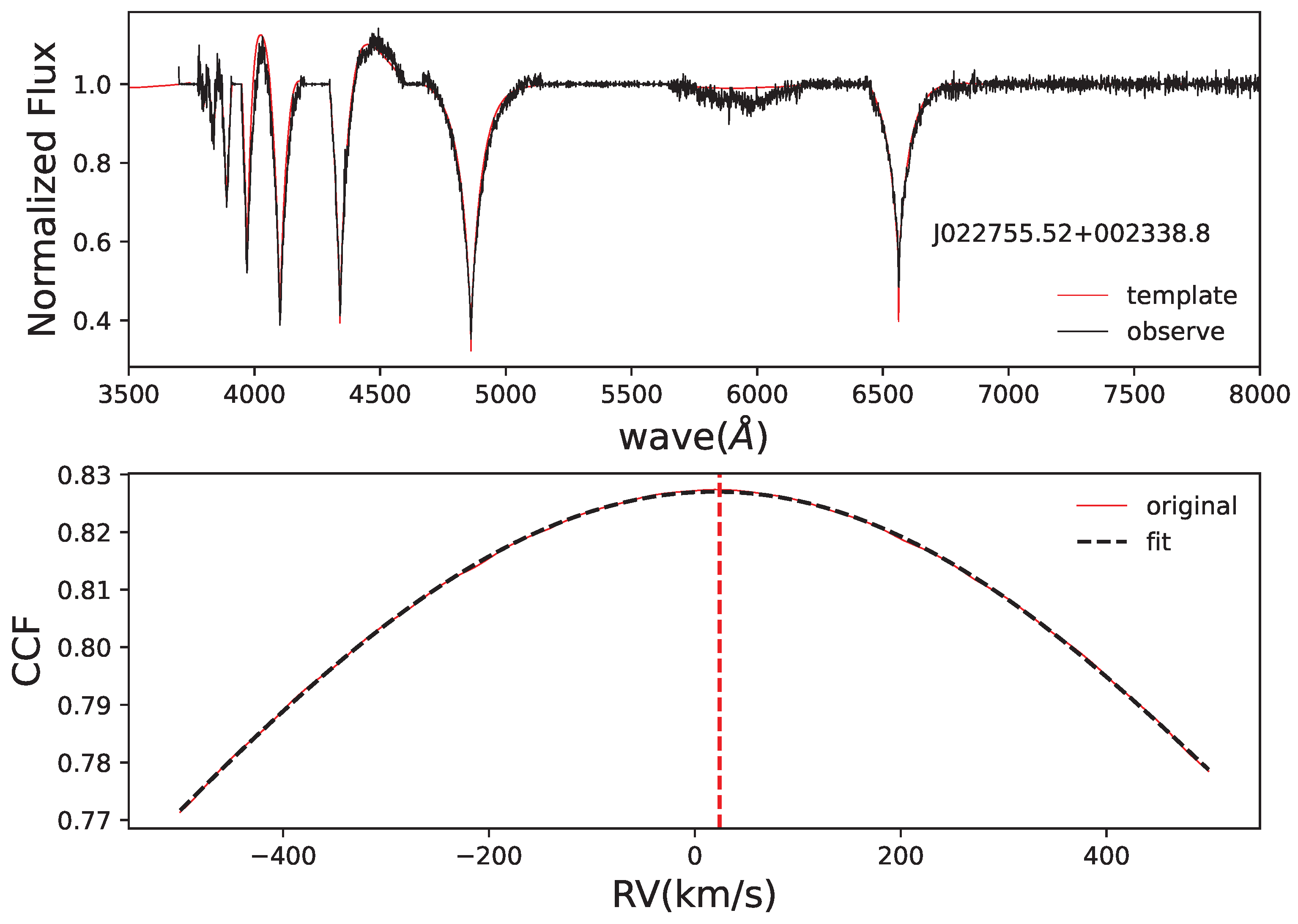


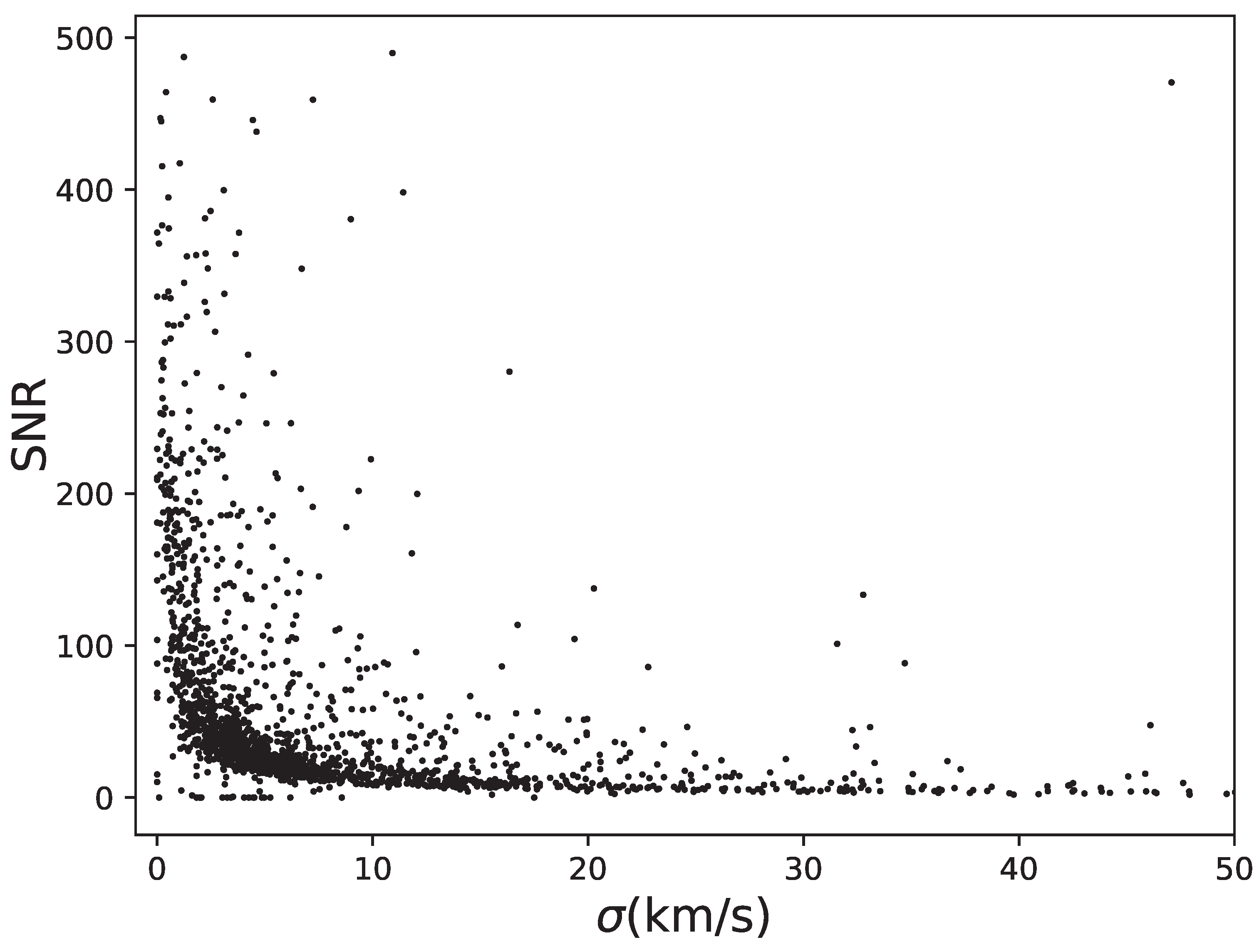
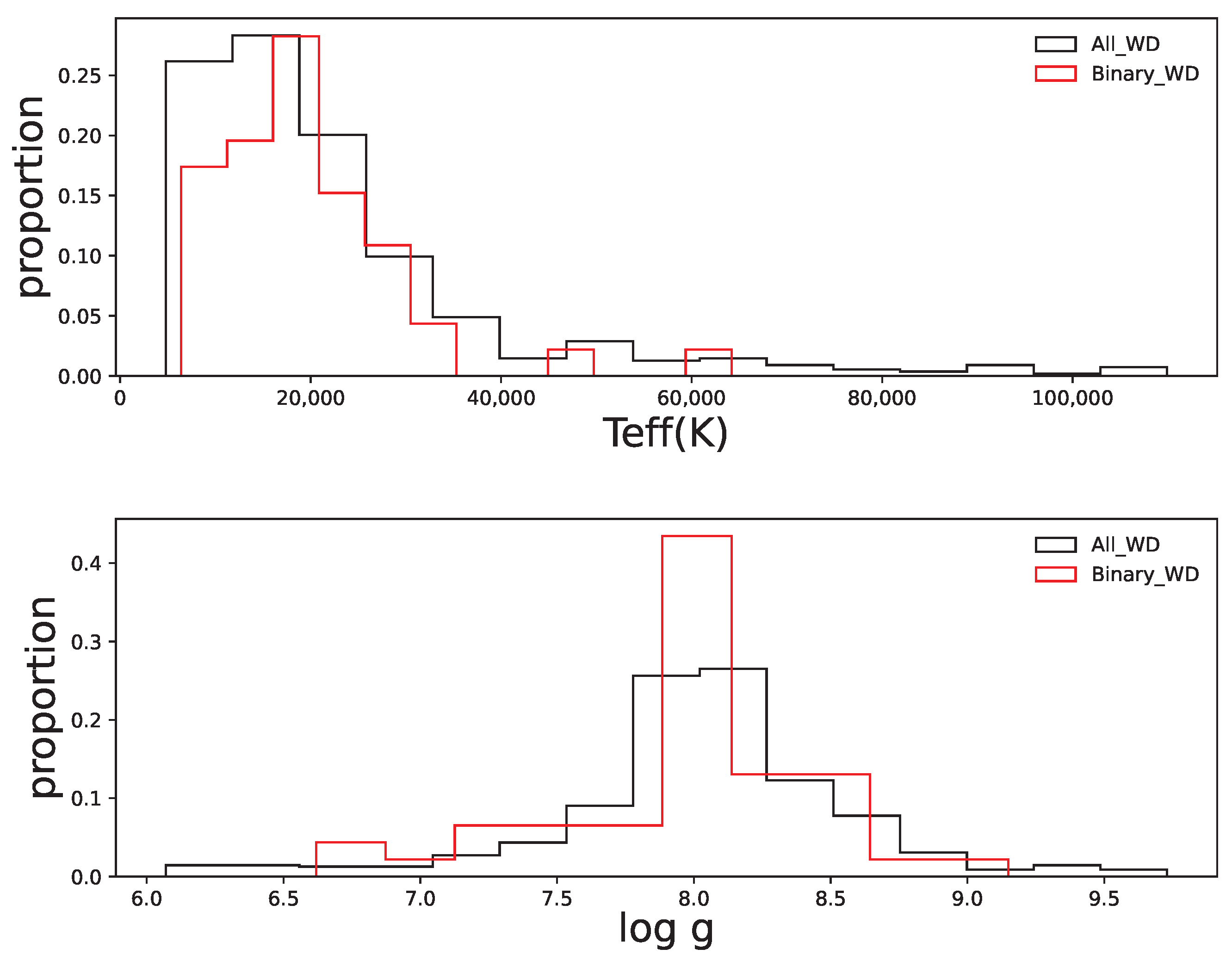
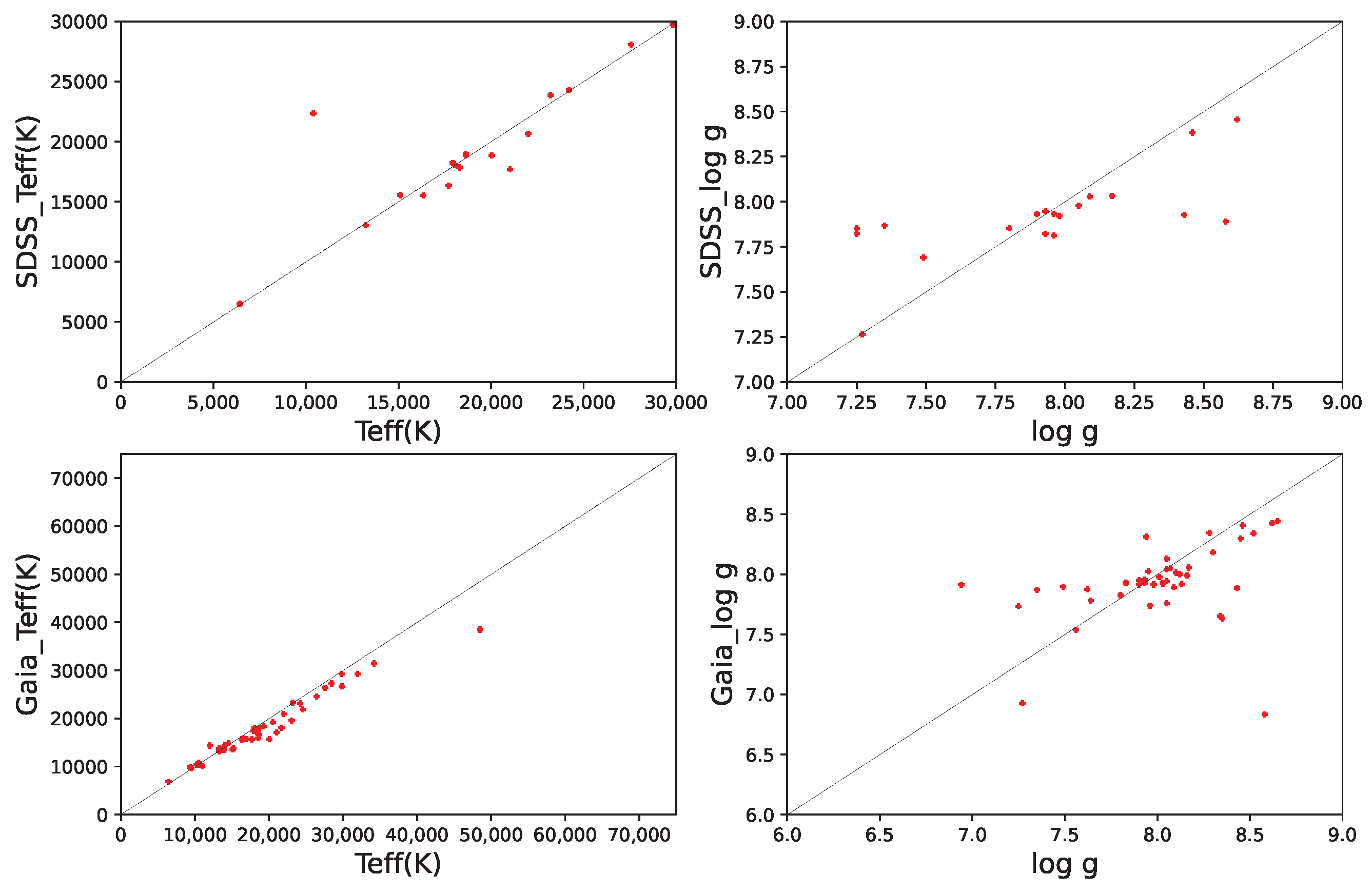
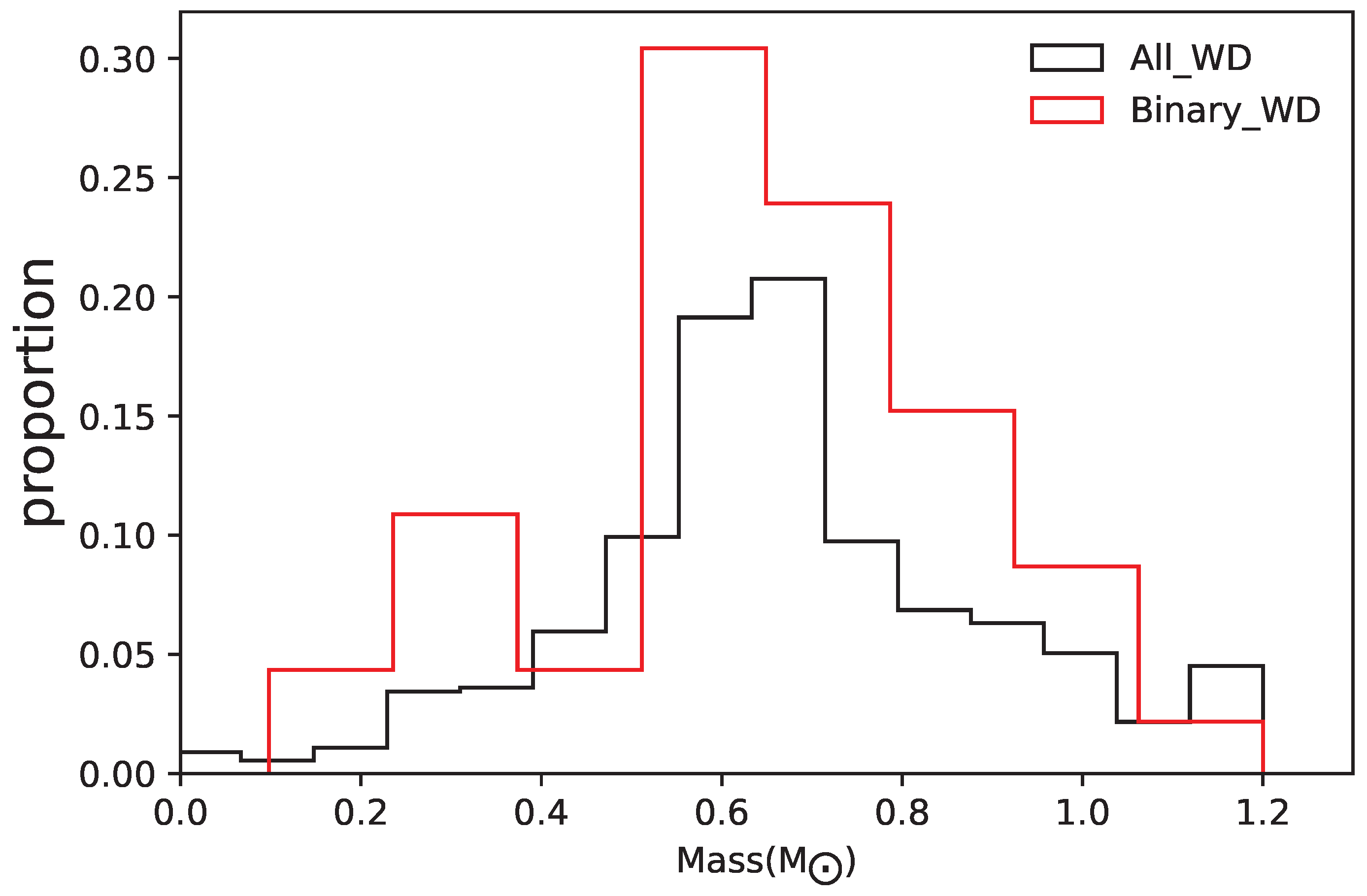
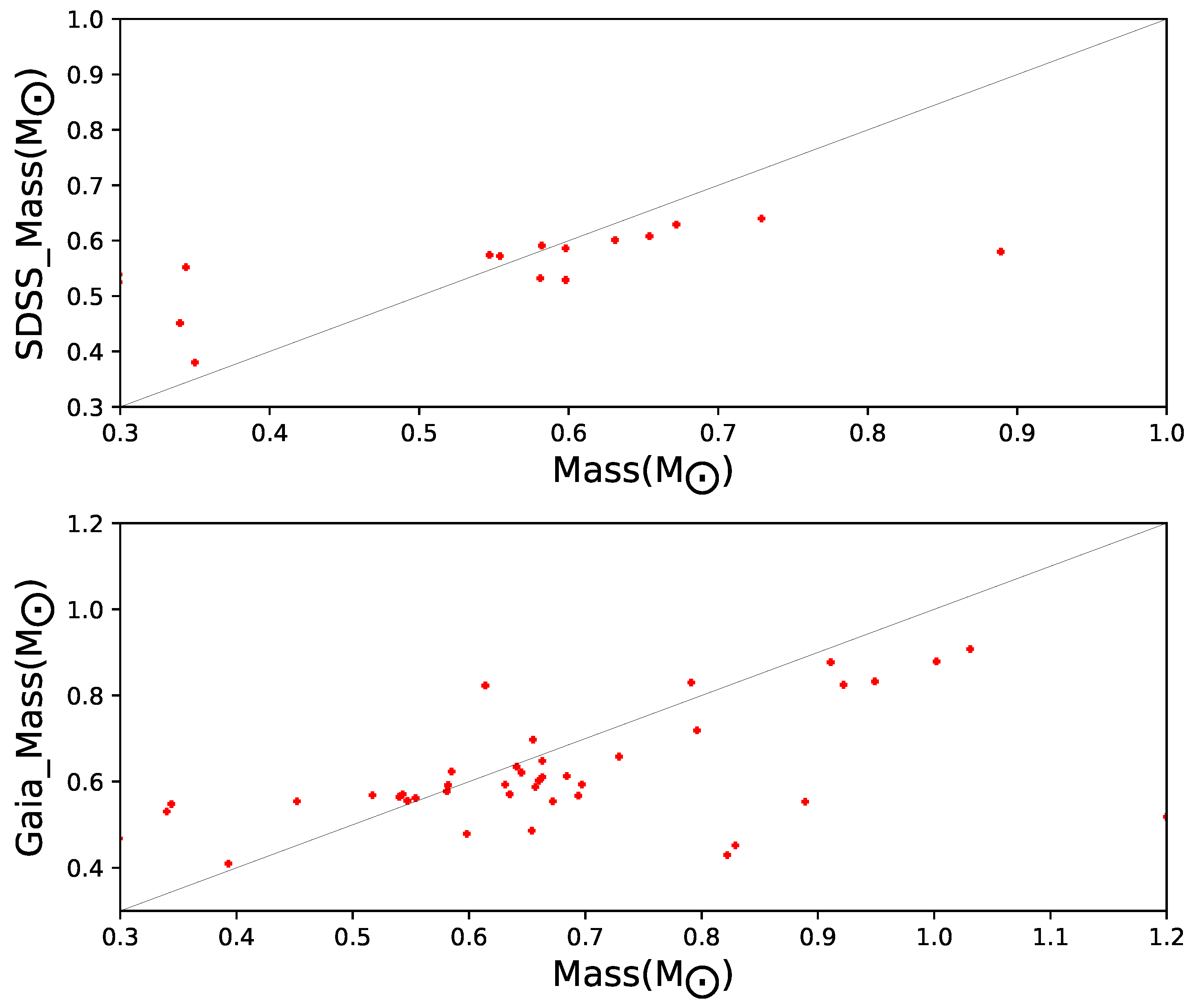
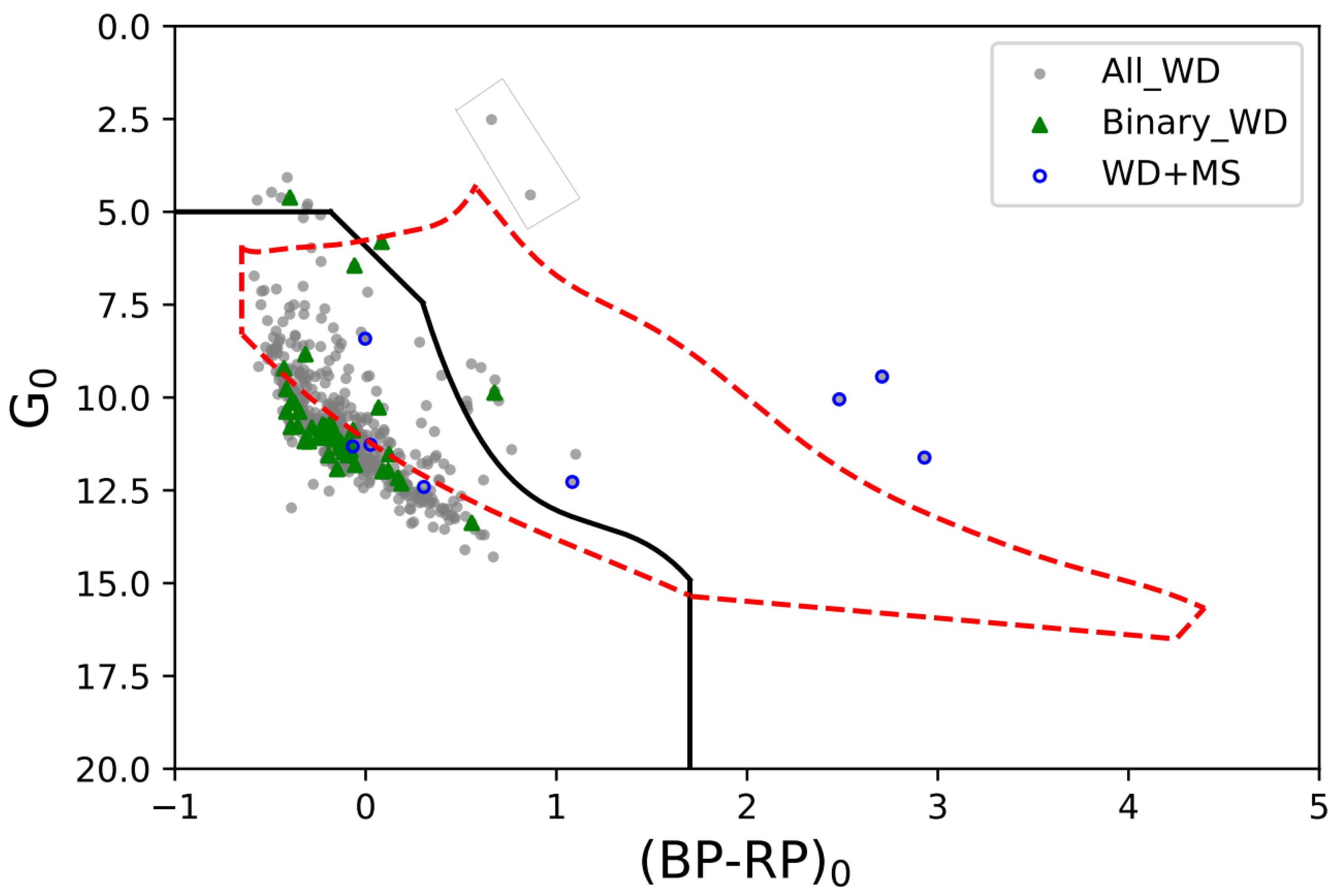
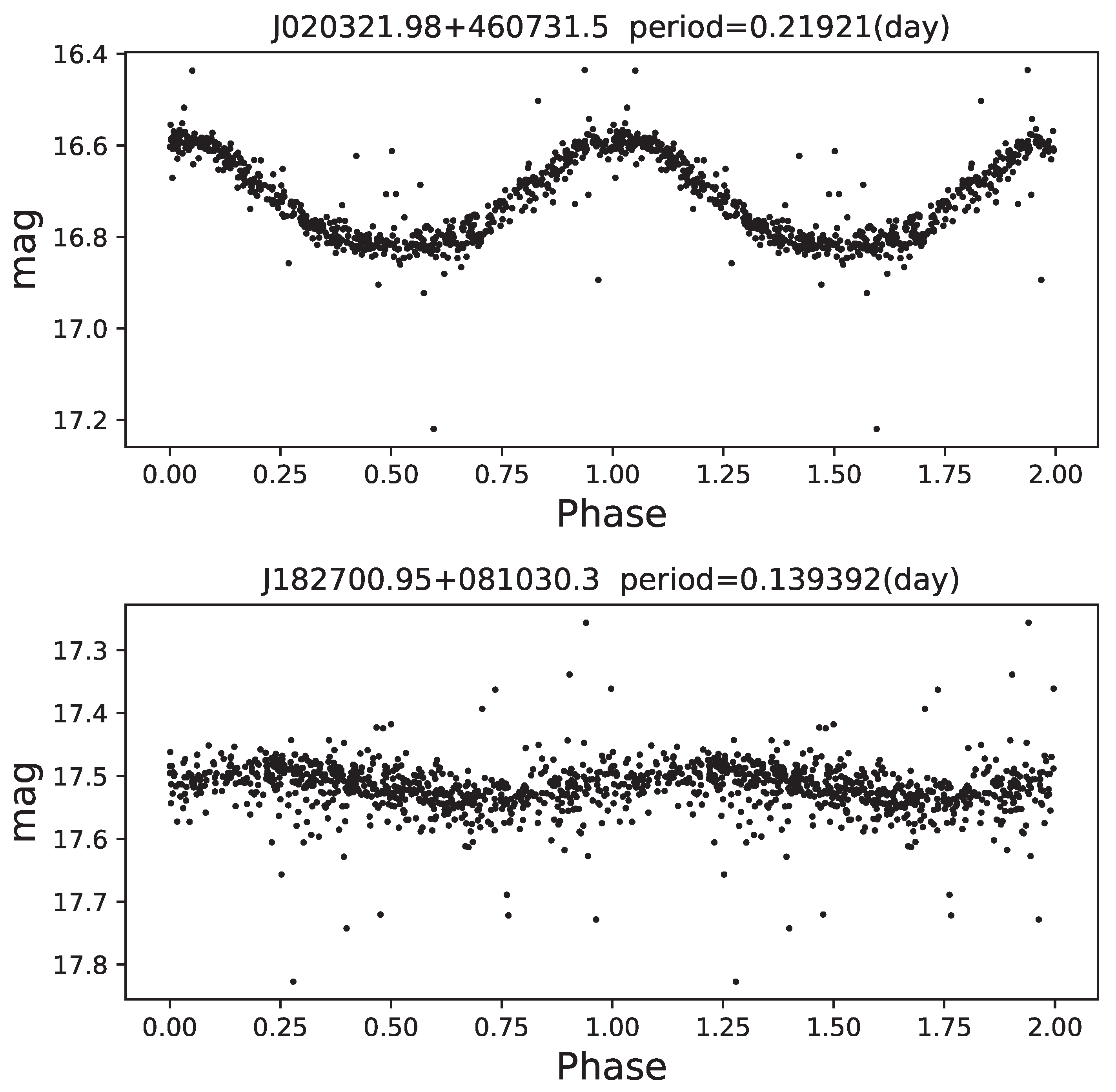
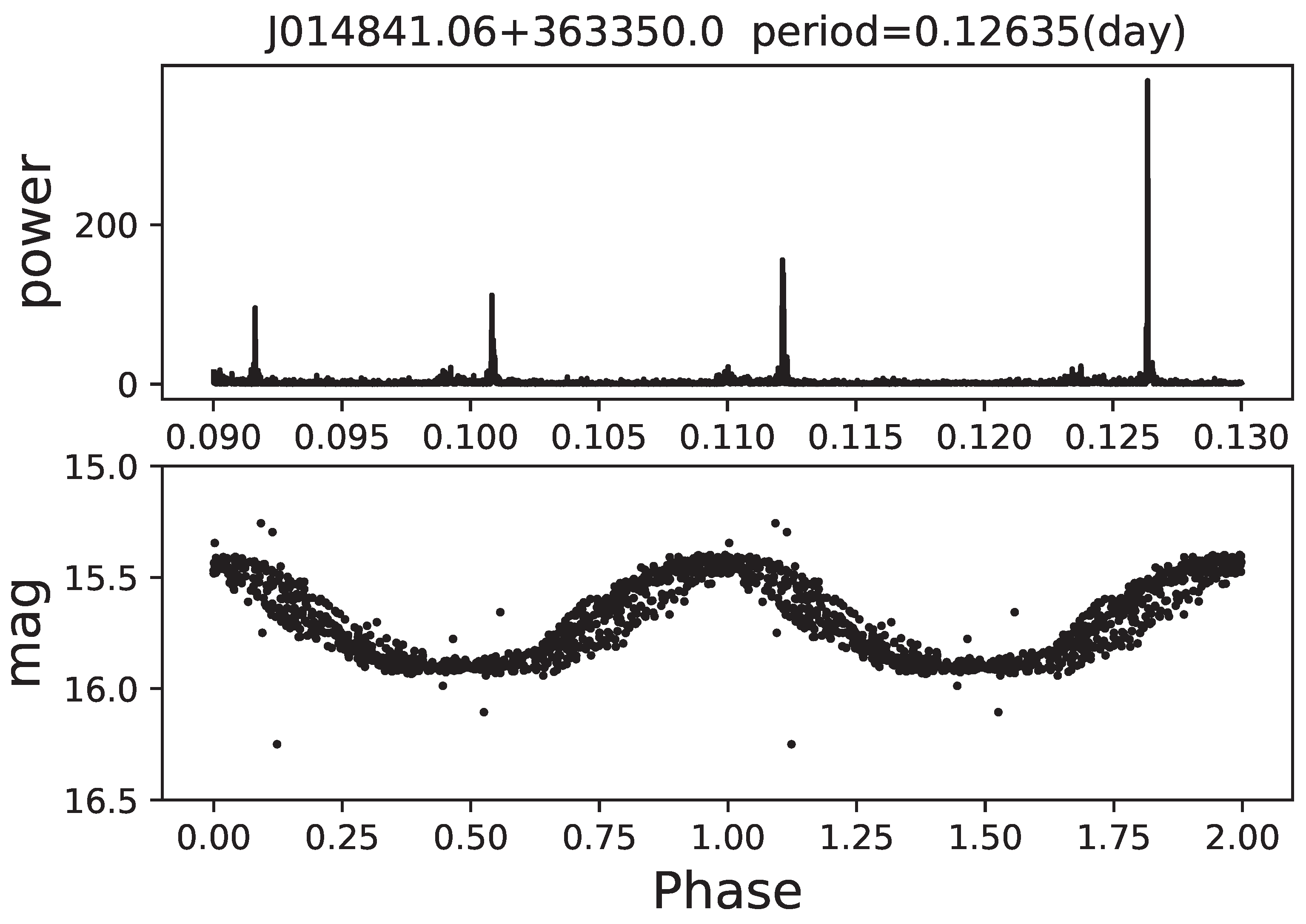

| RV_Mean (km/s) | RV_err (km/s) | obj |
|---|---|---|
| 46.35 | 9.61 | J000103.38 + 483843.9 |
| −51.46 | 21.78 | J000103.38 + 483843.9 |
| 65.67 | 7.27 | J001518.26 + 362352.4 |
| 73.56 | 36.81 | J001518.26 + 362352.4 |
| −16.71 | 8.21 | J001518.26 + 362352.4 |
| 64.37 | 11.04 | J001518.26 + 362352.4 |
| 43.92 | 17.13 | J001518.26 + 362352.4 |
| 51.78 | 24.21 | J004036.79 + 413138.7 |
| 31.73 | 21.56 | J004036.79 + 413138.7 |
| 0.87 | 22.25 | J004036.79 + 413138.7 |
| −0.63 | 2.36 | J005340.52 + 360116.6 |
| −99.47 | 2.56 | J005340.52 + 360116.6 |
| 10.52 | 4.77 | J010441.30 + 094942.4 |
| 31.97 | 5.22 | J010441.30 + 094942.4 |
| RV_mean km/s | RV_err km/s | RA deg | DEC deg |
|---|---|---|---|
| 8.05 | 34.33 | 148.234 | 42.504 |
| 9.32 | 14.73 | 148.234 | 42.504 |
| −6.22 | 11.26 | 148.234 | 42.504 |
| −4.87 | 15.17 | 148.234 | 42.504 |
| 79.09 | 5.08 | 144.285 | 33.567 |
| −3.96 | 13.92 | 133.744 | 27.873 |
| −7.71 | 10.19 | 159.227 | 37.477 |
| 10.18 | 10.08 | 159.227 | 37.477 |
| −8.59 | 7.18 | 159.227 | 37.477 |
| 1.96 | 6.31 | 141.056 | 27.575 |
| 15.32 | 7.97 | 141.056 | 27.575 |
| −9.94 | 5.82 | 145.361 | 29.750 |
| −97.68 | 9.08 | 141.800 | 28.774 |
| 67.45 | 10.27 | 141.800 | 28.774 |
| −101.05 | 7.46 | 141.800 | 28.774 |
| 12.41 | 6.28 | 222.058 | 28.419 |
| −28.27 | 7.18 | 181.354 | 30.579 |
| −11.03 | 5.43 | 191.069 | 23.236 |
| −0.61 | 6.13 | 193.174 | 19.257 |
| −12.09 | 5.93 | 115.342 | 15.655 |
| Designation | Type | Period (Days) |
|---|---|---|
| J023507.54 + 034356.8 | DA + M | |
| J102727.62 + 420916.8 | DA + M | |
| J000448.23 + 343627.4 | DA + M | |
| J002633.24 + 390902.9 | DA + M | |
| J002641.22 + 433224.3 | DA + M | |
| J050639.27 - 030138.7 | DA + M | |
| J085426.25 + 374653.0 | DA + M | |
| J152008.32 + 001126.1 | DA + M | |
| J133601.79 + 482846.1 | DA + M | |
| J154054.09 + 525243.3 | DA + M | |
| J041642.32 + 321119.8 | DA + M | |
| J172406.14 + 562003.0 | CV | |
| J084303.98 + 275149.6 | CV | |
| J014841.06 + 363350.0 | CV | 0.12635 |
| J133941.12 + 484727.4 | CV |
| Designation | RA (deg) | DEC (deg) | Period (Days) |
|---|---|---|---|
| J020321.98 + 460731.5 | 30.842 | 46.125 | 0.219210 |
| J182700.95 + 081030.3 | 276.754 | 8.175 | 0.139392 |
Disclaimer/Publisher’s Note: The statements, opinions and data contained in all publications are solely those of the individual author(s) and contributor(s) and not of MDPI and/or the editor(s). MDPI and/or the editor(s) disclaim responsibility for any injury to people or property resulting from any ideas, methods, instructions or products referred to in the content. |
© 2023 by the authors. Licensee MDPI, Basel, Switzerland. This article is an open access article distributed under the terms and conditions of the Creative Commons Attribution (CC BY) license (https://creativecommons.org/licenses/by/4.0/).
Share and Cite
Yan, H.-H.; Zhao, J.-K.; Shi, W.-B.; Guo, J.-C.; Wang, L.; Lei, Z.-X.; Zhao, G. Search for DA White Dwarf Binary Candidates from LAMOST DR7. Universe 2023, 9, 177. https://doi.org/10.3390/universe9040177
Yan H-H, Zhao J-K, Shi W-B, Guo J-C, Wang L, Lei Z-X, Zhao G. Search for DA White Dwarf Binary Candidates from LAMOST DR7. Universe. 2023; 9(4):177. https://doi.org/10.3390/universe9040177
Chicago/Turabian StyleYan, Hua-Hui, Jing-Kun Zhao, Wei-Bin Shi, Jin-Cheng Guo, Liang Wang, Zhen-Xin Lei, and Gang Zhao. 2023. "Search for DA White Dwarf Binary Candidates from LAMOST DR7" Universe 9, no. 4: 177. https://doi.org/10.3390/universe9040177
APA StyleYan, H.-H., Zhao, J.-K., Shi, W.-B., Guo, J.-C., Wang, L., Lei, Z.-X., & Zhao, G. (2023). Search for DA White Dwarf Binary Candidates from LAMOST DR7. Universe, 9(4), 177. https://doi.org/10.3390/universe9040177






